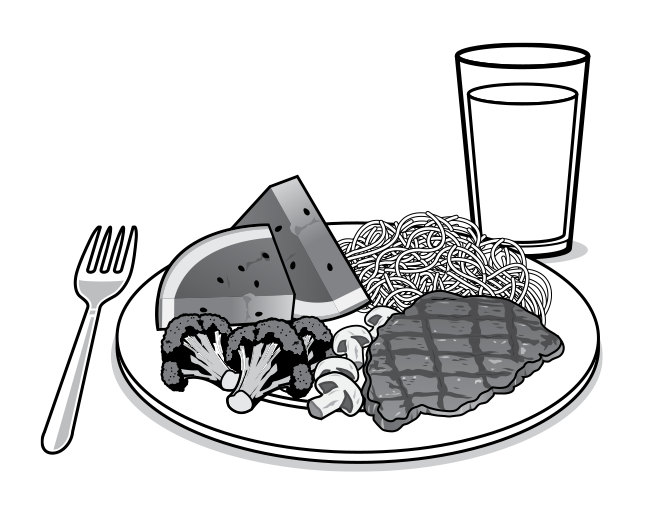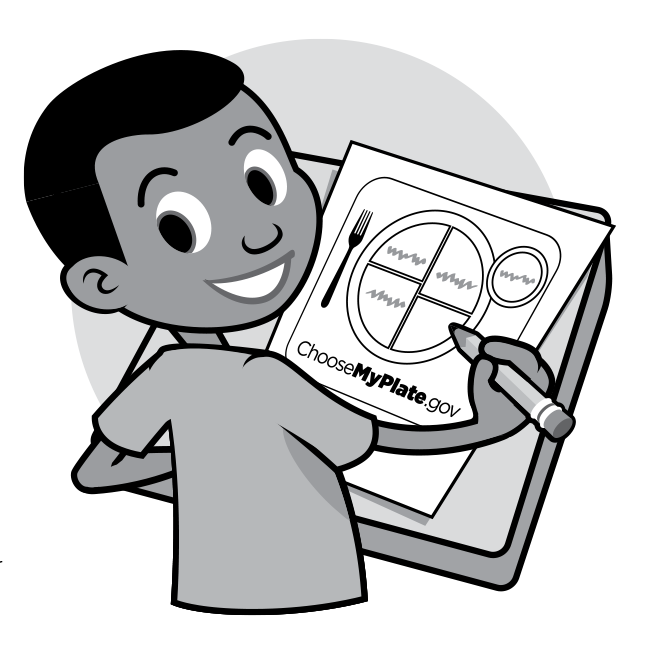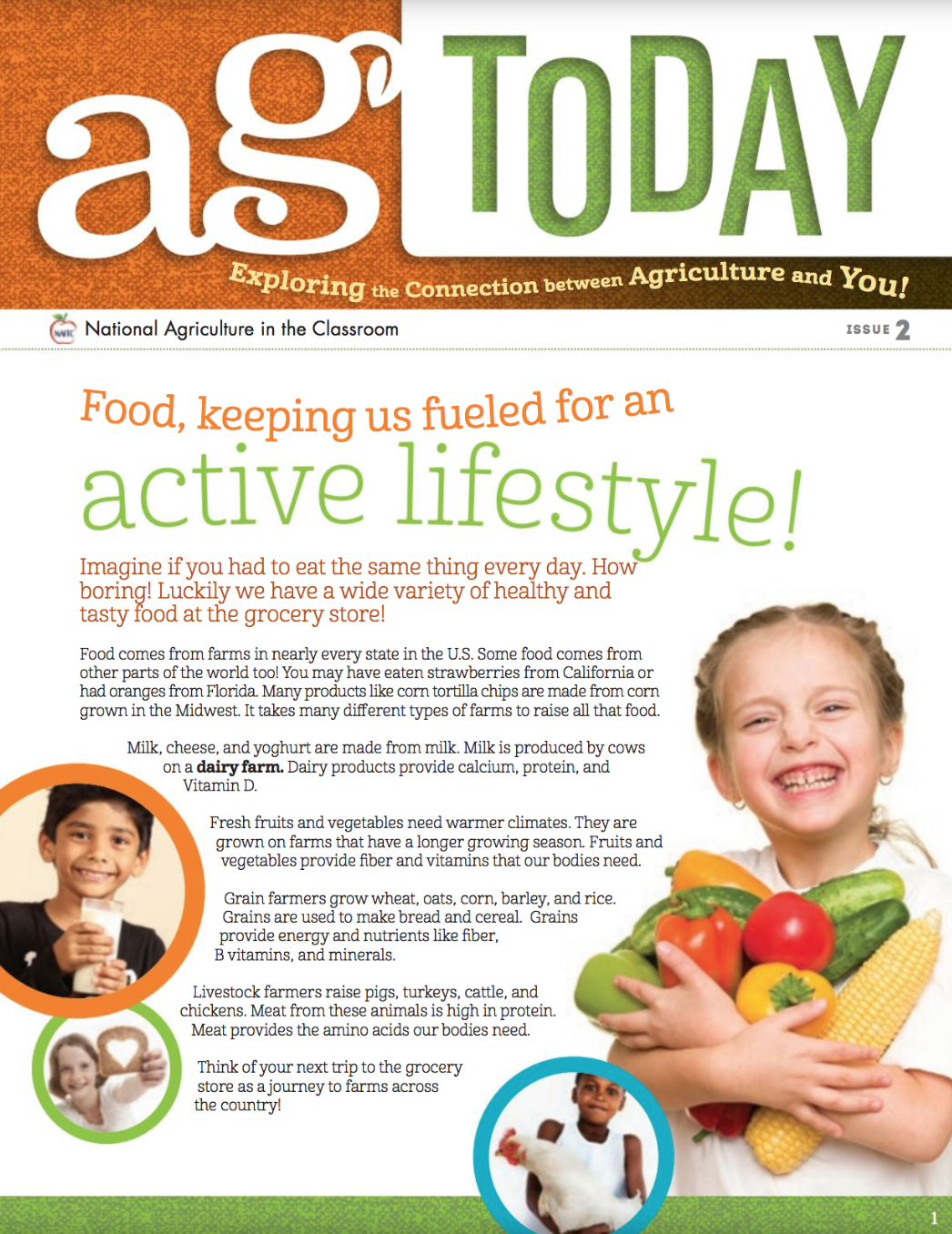Curriculum Matrix
Lesson Plan
Making Half MyPlate Fruits and Vegetables
Grade Level
Purpose
Students examine MyPlate and discover the importance of making half their plate fruits and vegetables. Grades 3-5
Estimated Time
Materials Needed
For the class:
- 1-cup measuring cup
- Two dominoes
For each student:
- MyPlate handout
- MyPlate Daily Food Plan Checklist
- Fruits and Veggies on MyPlate
- Have Fun With Fruits and Vegetables
- Have Fun With Fruits and Vegetables Answer Key
Elaborate
Vocabulary
cup equivalent: the amount of a food product that is considered equal to 1 cup from the vegetable, fruit, or milk food group; for some foods it is less than a measured cup due to concentration, other foods may be more than a cup if they are airy in their raw form and do not compress well into a cup (such as salad greens)
MyPlate: nutritional guide published by the United States Department of Agriculture (USDA); icon depicting a place setting with a plate and glass divided into five food groups
Background Agricultural Connections
This lesson is part of a series called Fruits and Vegetables for Health, which introduces students to the production, distribution, and nutritional value of fresh produce. Students will gain knowledge in geography, language arts, science, and math as they learn about the process through which fruits and vegetables are transported from farms to kitchen tables. Other related lessons in this series include:
- Making Half MyPlate Fruits and Vegetables
- California Crops: From the Farm to the Table
- Nutritional Value of Fresh Produce
- The Chemistry of Fruits and Vegetables
- My Life as a Fruit or Vegetable

The Dietary Guidelines for Americans promotes the importance of a healthy eating pattern to maintain health and reduce the risk of disease. Everything you eat and drink—the food and beverage choices we make day to day and over our lifetime—matters. By eating a variety of foods from each food group, we give our bodies what they need to be and stay healthy. Start with small changes to make healthier choices you can enjoy.
The MyPlate logo serves as a colorful visual that a person should eat foods from the five food groups each day. It is important to eat a variety of healthy foods. Find your healthy eating style and maintain it for a lifetime. Try to:
- Make half your plate fruits and vegetables.
- Focus on whole fruits
- Vary your veggies.
- Make half your grains whole grains.
- Move to low-fat and fat-free milk or yogurt.
- Vary your protein choices.
- Drink and eat less sodium, saturated fat, and added sugars.
- Children 6-17 years old should move at least 60 minutes each day.
This lesson will focus on encouraging students to choose foods based on the Dietary Guidelines for Americans and MyPlate recommendations, with special attention to the goal: Make half your plate fruits and vegetables.
Engage
- Ask your students to hold up five fingers.
- Once they have their hand held up, explain to them that just like we have five fingers, there are five food groups that are a part of a healthy diet.
- Ask students to help you list the five food groups. Allow them to use their prior knowledge, then give clues as needed.
Explore and Explain
 Distribute the MyPlate handout to each student. Briefly review the five food groups. The fruits and vegetables sections take up half the plate, with the vegetable food group being slightly larger than the fruit group. The grains section is larger than the protein section. Each food group’s size is slightly different because our bodies need different amounts from each food group to stay healthy.
Distribute the MyPlate handout to each student. Briefly review the five food groups. The fruits and vegetables sections take up half the plate, with the vegetable food group being slightly larger than the fruit group. The grains section is larger than the protein section. Each food group’s size is slightly different because our bodies need different amounts from each food group to stay healthy.- Have the students write a one-minute “quick list” of foods that could be listed in each of the five groups.
- Have students share their answers and record them in a chart on the board. Create a spelling list from select words.
- Lead students through a discussion of five reasons why they should make half their plate fruits and vegetables daily. Discussion points may include:
- Fruits and vegetables are the only source of vitamin C in the diet. Vitamin C helps the body heal wounds and lowers the risk of infection. It also helps keep the body from bruising and builds the tissue that holds muscles and bones together. Vitamin C is also known as ascorbic acid and helps the body absorb the iron found in foods and strengthens the immune system.
- Vitamin A serves several functions in the body. It helps maintain good vision, fight infection, support cell growth, and keep skin healthy. Leafy greens, carrots, sweet potatoes, squash, spinach, apricots, and green peppers are all excellent sources of vitamin A.
- Fruits and vegetables are a good source of complex carbohydrates, whose energy release is slow, gradual, and long lasting. Sugar provides quick energy, but its effects are short lived. This knowledge is important when choosing foods to eat before an athletic event.
- Fruits and vegetables contain fiber. Fiber helps move food through the body to prevent constipation and provide a sense of fullness.
- Fruits and vegetables are quick, often ready to eat, easy to carry, and tasty foods to have as snacks. They provide the energy needed to function throughout the day.
- Eating a variety of fruits and vegetables provides health benefits— people who eat more fruits and vegetables as part of a healthy eating style are likely to have a reduced risk of some chronic diseases.
- Fruits and vegetables provide nutrients that help us grow and stay healthy.
- They are naturally low in fat and calories. None have cholesterol.
- Briefly discuss what foods are in the fruit and vegetable groups using the MyPlate Daily Food Plan Checklist.
- Fruit Group:
- Any fruit or 100% fruit juice counts as part of the Fruit Group. Fruits may be fresh, canned, frozen, or dried, and may be whole, cut-up, or pureed. For more information and fruit group photos visit the All About the Fruit Group webpage.
- Focus on whole fruits
- Choose whole or cut up fruits more often than 100% juice.
- Snack on fresh, frozen, canned, or dried fruits instead of cookies, brownies, or other sugar-sweetened treats.
- Vegetable Group:
- Any vegetable or 100% vegetable juice counts as a member of the Vegetable Group. Vegetables may be raw or cooked; fresh, frozen, canned, or dried/dehydrated; and may be whole, cut-up, or mashed. For more information and vegetable group photos visit the All about the Vegetable Group webpage.
- Vegetables are organized into 5 subgroups based on their nutrient content:
- Dark-Green Vegetables (e.g., broccoli, spinach, romaine lettuce, bok choy, collard greens)
- Red and Orange Vegetables (e.g., acorn or butternut squash, carrots, pumpkin, red peppers, sweet potatoes, tomatoes)
- Beans and Peas Vegetables (e.g., chickpeas/garbanzo beans; lentils; black, kidney, navy, or pinto beans)
- Starchy Vegetables (e.g., corn, green peas, green lima beans, plantains, potatoes)
- Other Vegetables (e.g., celery, cucumbers, green beans, green peppers, iceberg lettuce, zucchini)
- Fruit Group:
- Discuss the importance of eating a variety of vegetables from each of the subgroups throughout the week. Vegetable subgroup recommendations are given as amounts to eat WEEKLY. It is not necessary to eat vegetables from each subgroup daily. Most people need to eat more vegetables from the Dark-Green, Red and Orange, and Beans and Peas subgroups.
- Ask students to name their favorite vegetables in each of the subgroups. Write the subgroup categories on the board.
- Review the amount of food students need from each of the five food groups each day using the attached MyPlate Daily Food Plan Checklist. Direct the students to identify what foods are measured in cups vs. ounces. (The amounts of foods are listed in cups for fruits, vegetables, and dairy, and in ounce equivalents for grains and protein foods.) To help students see what these foods might look like on a plate, use measuring cups for volume and two dominoes for one-ounce equivalents.
- Show students what a 1/2 cup of fruits, vegetables, and cooked grains look like. Display the food on a plate. Have the students measure 1 or 2 cups of food to compare. Have the students hold two dominoes in their hand. Explain that the two dominoes are equal to one ounce.
- Have students complete the attached Fruits and Veggies on MyPlate handout.
Variations
- Create a large classroom model of the MyPlate icon. Have students identify and cut out their favorite fruits and vegetables from grocery ads. Students take turns sharing and taping their fruits and vegetables to the classroom model.
- Instead of creating a meal, instruct students to use healthy recipes found online or bring a family recipe from home. Use the MyMeal handout to record the different ingredients and their correlating serving sizes.
Elaborate
-
Play the My American Farm interactive game Finders Keepers.
-
 Read Issue 2 of Ag Today titled Food, Keeping us Fueled for an Active Lifestyle. This reader can be printed or accessed digitally. Learn about the healthy and tasty food that farmers grow to help humans maintain a healthy diet. Follow the process from farm to plate and learn about serving sizes, food safety, and USDA's MyPlate.
Read Issue 2 of Ag Today titled Food, Keeping us Fueled for an Active Lifestyle. This reader can be printed or accessed digitally. Learn about the healthy and tasty food that farmers grow to help humans maintain a healthy diet. Follow the process from farm to plate and learn about serving sizes, food safety, and USDA's MyPlate. -
Have students try the Have Fun with Fruits and Vegetables Word Search.
-
Using the list of fruits and vegetables the students created in the lesson, have the students determine which produce items are high in vitamin A. This can be done using the “dark color test.” Produce high in vitamin A is dark orange, dark yellow, or dark green throughout.
-
Rate the taste! Conduct a tasting using fruits and vegetables that are new to your students. For taste testing tips, visit Illinois Harvest of the Month's Taste Test Toolkit.
Evaluate
After conducting these activities, review and summarize the following key concepts:
- Fruits and vegetables are part of a healthy diet and should constitute half of the proportions of our plates.
- Fruits and vegetables provide vitamins, minerals, and fiber to our diet.
- Serving sizes help us know how much of each food group we should eat per day.
Acknowledgements
This lesson was originally developed in 1996 through a partnership between the Fresh Produce and Floral Council, the California Farm Bureau Federation, and the California Foundation for Agriculture in the Classroom. Fruits and Vegetables for Health was updated in 2012 in partnership with the California Department of Public Health’s Network for a Healthy California with funding from USDA SNAP, known in California as CalFresh (formerly Food Stamps). Funding for 2017 updates were provided through a California Agriculture Special Interest License Plate grant (CalAgPlate) that supports agricultural education, agricultural career training, and agricultural leadership development.
Original Authors: Brenda Byers and Priscilla Naworski
Executive Director: Judy Culbertson
Illustrator: Erik Davison
Layout and Design: Nina Danner
Special thanks to Harvest of the Month
Recommended Companion Resources
- A Seedy Fruit Challenge
- Ag Today
- AgBadging Field Guide
- Eat & Move O-Matic
- Fill MyPlate Game
- Food Models
- Fruit Bowl
- Good Enough to Eat: A Kid's Guide to Food and Nutrition
- I Will Never Not Ever Eat a Tomato
- Jack & the Hungry Giant Eat Right with MyPlate
- Look Inside Food
- My American Farm
- MyPlate
- MyPlate Activity Poster
- Nutrition Posters
- Oliver's Fruit Salad
- The Healthy Hop 'n Shop
Author
Organization
| We welcome your feedback! If you have a question about this lesson or would like to report a broken link, please send us an email. If you have used this lesson and are willing to share your experience, we will provide you with a coupon code for 10% off your next purchase at AgClassroomStore. |
